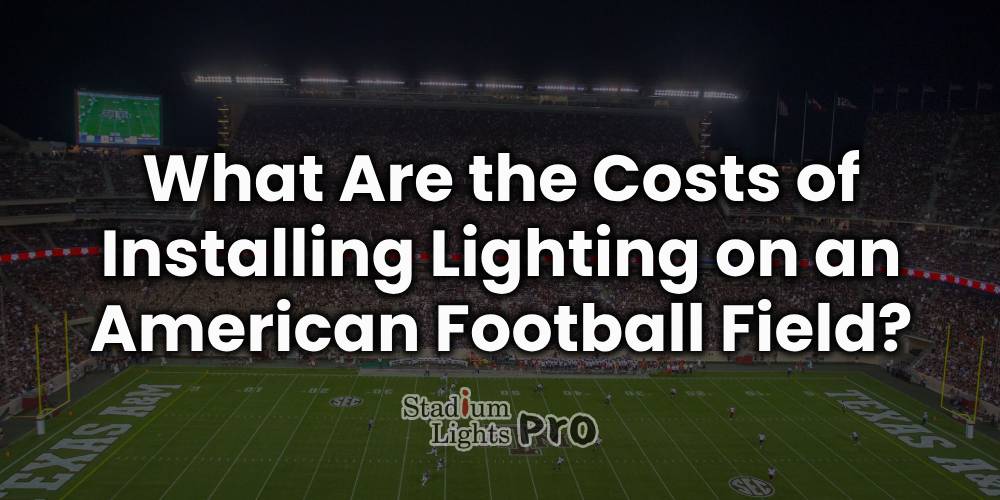Lighting of modern American football fields allows games to be played during the evening hours and improving the overall experience for both players and spectators. The installation of lighting for these fields requires careful planning, design, and budgeting. The cost of installing football field lighting can vary widely depending on several factors, such as the type of lighting system, the size of the field, and the specific needs of the venue. In this discussion, we will explore the various elements that contribute to the installation cost of football field lighting.
Table of Contents
ToggleInstallation Process
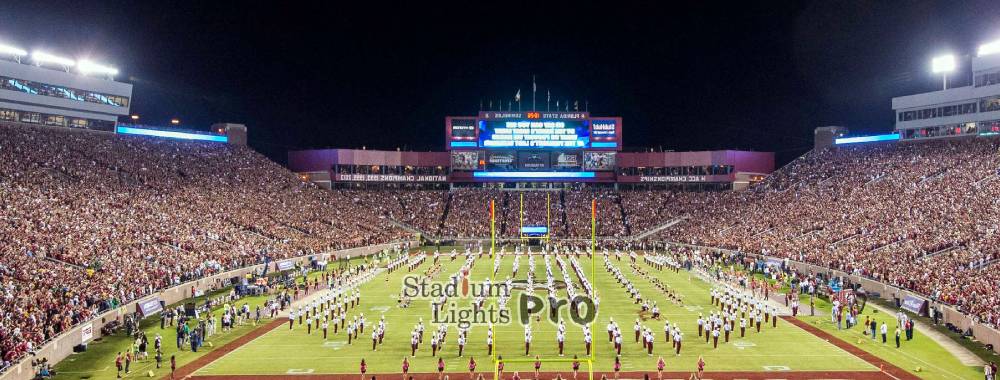
Once the design and planning stages are complete, the actual installation of the lighting system begins. This process involves a series of carefully coordinated steps that ensure the lighting system is not only functional but also safe and efficient. From the preparation of the site to the final wiring connections, each phase plays a pivotal role in the successful completion of the project. The installation steps typically include site preparation, pole installation, fixture setup, and electrical wiring, all of which require careful planning and skilled labor.
Site Preparation and Foundation Work
The first and one of the most important steps in the installation process is preparing the site for the lighting system. This phase begins with excavation work for the foundations of the light poles. These foundations must be durable enough to withstand the weight and pressure exerted by the lighting fixtures and poles, which are exposed to various environmental conditions, such as wind and rain. Depending on the soil type, weather conditions, and terrain of the field, the foundation work can range from simple digging to more complex procedures that may require additional equipment or materials.
In some cases, the ground may need to be reinforced, especially if the soil is soft or sandy. In such instances, concrete may be poured into the foundation holes to create a solid base that will securely hold the light poles in place. Special consideration is given to the depth and diameter of the foundations to ensure that the poles remain stable, even in harsh weather conditions. In addition to the basic excavation, some sites may require drainage systems to prevent water accumulation around the pole foundations, which could affect the stability of the poles over time.
Pole Installation and Fixture Setup
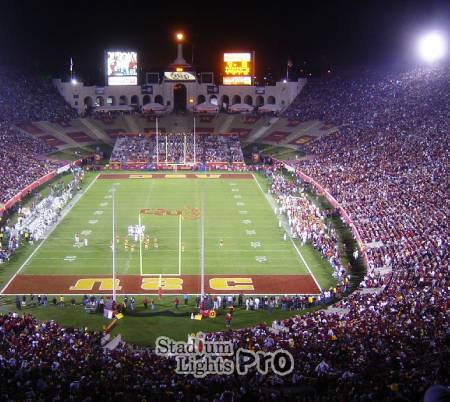 Once the foundations are complete and ready, the next step is the installation of the light poles. These poles are typically made of steel or other durable materials designed to resist wear and corrosion. The poles must be installed securely to avoid any safety risks, as they need to support the weight of the lighting fixtures, which can be substantial. The poles are typically tall to provide adequate illumination over the entire field, often reaching heights of 40 feet or more, depending on the size of the field.
Once the foundations are complete and ready, the next step is the installation of the light poles. These poles are typically made of steel or other durable materials designed to resist wear and corrosion. The poles must be installed securely to avoid any safety risks, as they need to support the weight of the lighting fixtures, which can be substantial. The poles are typically tall to provide adequate illumination over the entire field, often reaching heights of 40 feet or more, depending on the size of the field.
During installation, the poles are positioned and anchored into the foundation. This requires precision to ensure that the poles are perfectly vertical and aligned correctly across the field. If the poles are not positioned accurately, it could result in uneven lighting, causing certain areas of the field to be too bright or too dark. This misalignment can hinder the quality of play and negatively impact the safety of players. Therefore, the placement of the poles must be carried out with great care, often with the help of leveling equipment and professional installers.
After the poles are securely in place, the next step is mounting the lighting fixtures. These fixtures are typically heavy, and the process requires careful handling. Each fixture must be mounted at the right height and angle to provide optimal coverage. The position of each fixture is determined based on the field’s layout and the specific lighting design. The fixtures need to be positioned to ensure uniform lighting across the entire field, including the end zones, sideline areas, and midfield. Proper placement of the lights helps reduce shadows and ensures a consistent level of illumination, which is especially important for evening games and events. The positioning of the lights is a precise task that requires attention to detail to avoid creating zones with overly bright spots or insufficient lighting.
Electrical Wiring and Connections
Once the poles and lighting fixtures are installed, the next major task is the electrical wiring and connections. This phase of the installation is essential to ensure that the lighting system operates correctly and safely. Skilled electricians are needed to run the electrical wiring from the lighting fixtures to the central electrical panel. This wiring needs to be both secure and protected from potential damage, as exposure to the elements or physical impact could cause electrical hazards.
The wiring setup typically includes running heavy-duty cables through underground conduits to ensure the system’s durability. The wiring must be sized appropriately to handle the electrical load of the lights, with sufficient capacity to handle the voltage required by the lighting system. Additionally, the wiring must be routed to the power supply, which might be located in a utility room or a nearby electrical box. Depending on the site, the electrical connections may also require transformers to convert the power to the appropriate voltage for the lighting fixtures.
In this phase, control systems are also installed to regulate the lighting system. These control systems allow the lighting to be turned on and off, and they may also provide features such as dimming or automatic adjustment based on the time of day or weather conditions. For larger installations, remote control systems can be used to operate the lighting from a distance, which is particularly useful for events or when lighting needs to be managed across multiple fields. The electrical systems must be thoroughly tested before the lights are turned on to ensure there are no faults or risks associated with the wiring or connections.
Once the electrical wiring is completed and tested, the final step is to connect the system to a power supply, allowing the lights to be activated and used for their intended purpose. This phase also includes testing the lighting levels to ensure the entire field is evenly lit, making adjustments as necessary to achieve the correct balance of illumination.
Cost Breakdown
| Component | Cost Range |
|---|---|
| Lighting Fixtures (Metal Halide) | $500 – $1,500 per fixture |
| Lighting Fixtures (LED) | $1,000 – $2,500 per fixture |
| Steel Poles (Standard) | $1,000 – $2,500 each |
| Steel Poles (Custom/Taller) | $2,500 – $5,000 each |
| Electrical Infrastructure (Basic) | $5,000 – $10,000 |
| Electrical Infrastructure (Advanced) | $10,000 – $20,000 |
| Labor Costs (Small to Mid-sized Project) | $10,000 – $20,000 |
| Labor Costs (Larger/Complex Project) | $20,000 – $30,000 |
| Permits and Fees (Small Projects) | $500 – $2,000 |
| Permits and Fees (Large Projects) | $2,000 – $5,000 |
| Transportation and Logistics | $1,000 – $5,000 |
| Site Cleanup and Restoration | $500 – $3,000 |
| Upgrades to Existing Infrastructure | $5,000 – $15,000 |
After examining the various factors and the installation process, it is time to explore the cost breakdown for installing lighting on an American football field. The total expense of such a project depends on several components, and these can fluctuate significantly based on location, material choices, and project complexity. The following sections will provide an overview of the various cost components typically associated with lighting installations, including the major aspects that contribute to the overall cost.
Lighting Fixtures and Poles
Lighting fixtures and poles represent a substantial portion of the overall cost when installing lighting on a football field. The price of lighting fixtures depends mainly on the type of lights selected. There are two primary lighting options: metal halide lights and LED lights. Metal halide lights are usually less expensive upfront but tend to incur higher operational costs, including frequent maintenance and higher energy consumption. On the other hand, LED lights have a higher initial cost but offer several benefits, including energy efficiency, longer lifespan, and lower maintenance needs. The cost of lighting fixtures varies depending on the type, wattage, and quality of the lights. Typically, metal halide lights can range from $500 to $1,500 per fixture, while LED lights cost between $1,000 and $2,500 per unit.
The poles that support the lighting fixtures are another key factor in the total cost. These poles are typically constructed from steel, aluminum, or galvanized materials, designed to endure the weight of the lights and withstand weather conditions. The cost of poles varies depending on height, material, and customization. Standard steel poles usually cost between $1,000 and $2,500 each, while custom or taller poles, which can reach up to 80 feet in height, can cost anywhere from $2,500 to $5,000 each. The number of poles required is typically between 6 to 8, although this number can increase for larger fields or more advanced lighting systems.
Electrical Infrastructure
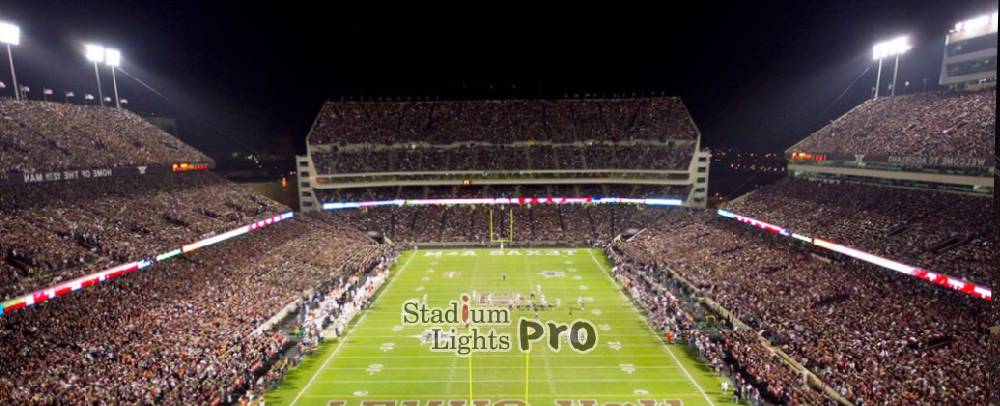
The electrical infrastructure required to support the lighting system is another significant expense. This includes the installation of transformers, electrical wiring, and control systems to ensure that the lights are properly powered and regulated. The cost of electrical work can vary depending on the complexity of the system and how far the power source is from the field. Basic electrical infrastructure typically costs between $5,000 and $10,000, while more advanced setups that include transformers, switchgear, and power distribution systems can range from $10,000 to $20,000.
In some cases, additional costs may arise if the field is located far from the nearest power source. For example, underground electrical lines can be expensive to install, with costs ranging from $10,000 to $25,000, depending on the length of the installation. Additionally, if a generator is required to power the lighting system, the cost can increase by another $5,000 to $15,000, based on the generator’s capacity and specifications.
Labor Costs
Labor costs play an important role in the overall expense of installing lighting on a football field. A team of skilled workers, including electricians, crane operators, construction workers, and project managers, is needed for the installation of the lighting system. Labor costs can vary significantly depending on the region and the complexity of the project. On average, labor costs for installing football field lighting range from $10,000 to $20,000 for smaller projects, while larger or more complex projects can cost between $20,000 and $30,000 or more.
Labor costs generally include excavation work, site preparation, pole and fixture installation, wiring, and system testing. It is also important to consider additional labor required for troubleshooting or making adjustments after the installation. The use of cranes for pole installation or specialized machinery for heavy lifting can also increase labor costs.
Permits and Fees
Obtaining the necessary permits and meeting local building codes and safety regulations is another often-overlooked expense in the installation process. Permits may be required when installing large-scale lighting systems, especially if the electrical system poses safety risks. The cost of permits can vary depending on location and the size of the project. Typically, permit costs for lighting installation range from $500 to $2,000 for smaller or local projects, while larger projects requiring multiple permits may cost between $2,000 and $5,000.
In addition to permit fees, other expenses may arise for inspections, environmental impact assessments, or compliance with local zoning laws. In some cases, large projects may require public hearings or consultations with local authorities, further increasing costs.
Additional Costs
Beyond the primary costs mentioned above, several other expenses may need to be considered when budgeting for a football field lighting installation. These include transportation and logistics costs for materials, which can range from $1,000 to $5,000, depending on the distance and delivery requirements. Additionally, site cleanup and restoration costs can vary from $500 to $3,000, depending on the scope of work and the condition of the field.
Upgrades to existing infrastructure, such as electrical or structural systems, may also be necessary to support the new lighting system. These upgrades can add anywhere from $5,000 to $15,000 or more to the total cost. By considering all these factors, a complete football field lighting installation project can cost anywhere from $50,000 to $200,000 or more, depending on the field’s size and the system’s complexity. It is crucial for anyone planning such an installation to collaborate with experienced professionals to ensure proper planning and budgeting for every aspect of the project.
Factors Influencing the Installation Cost
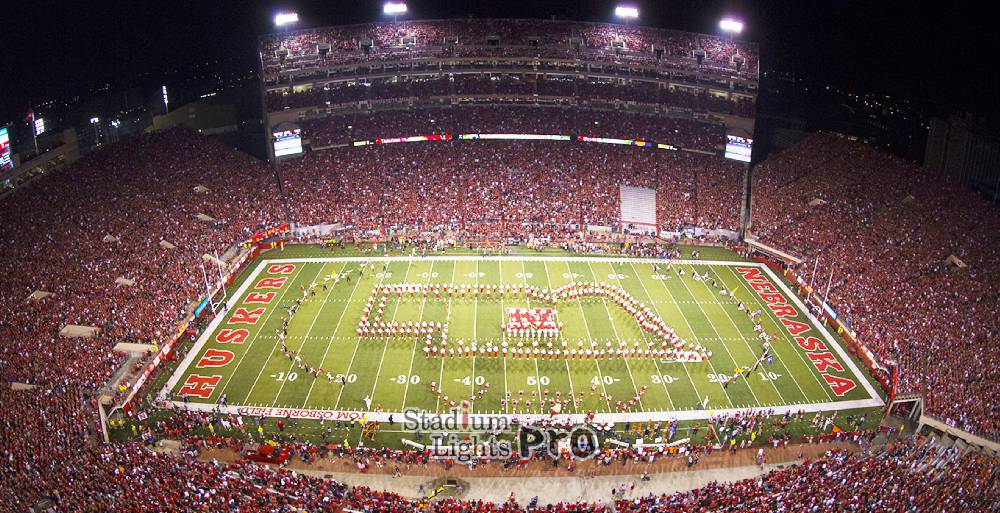
Various factors play a significant role in determining the final cost of installing lighting on an American football field. These factors can vary greatly depending on the specific requirements of the project, the location, and the desired outcome. Understanding these key elements is crucial when estimating the overall expense of the installation. Whether it’s the type of lighting system chosen, the size and layout of the field, or the complexity of the power supply and electrical requirements, each element can have a substantial impact on the final budget.
Type of Lighting System
The choice of lighting system is one of the most significant contributors to the overall installation cost. In general, there are two primary lighting options for football fields: metal halide lights and LED lights. Metal halide lights have traditionally been the go-to choice due to their lower upfront cost and availability. However, over the past decade, many sports facilities have started replacing metal halide lights with LED systems. The reason for this shift is primarily due to the long-term financial benefits offered by LED lights, including their longer lifespan, significantly lower energy consumption, and reduced maintenance costs.
While the initial installation cost for LED lighting can be higher, it often results in substantial savings over time, especially when considering the reduced frequency of bulb replacements and energy consumption. On the other hand, metal halide lights may require frequent maintenance and more energy, leading to higher operational costs in the long run. As a result, while metal halide lights are often selected for budget-conscious projects with shorter time frames, LED systems are becoming the preferred choice for those seeking an energy-efficient, long-lasting solution that will save money over time.
Field Size and Layout
The size of the football field directly impacts the lighting installation cost. Larger fields require more lighting fixtures to provide even illumination across the entire playing area. In addition to the number of fixtures, larger fields also necessitate the installation of additional electrical infrastructure to handle the increased demand for power. Moreover, the layout of the field can also influence the complexity of the installation. Fields with unusual shapes or multiple zones, such as those that incorporate different levels of elevation or sections designated for specific activities (e.g., practice areas), require more customized lighting designs. Custom lighting systems are designed to ensure that all parts of the field receive uniform light distribution, which often results in higher costs due to the specialized equipment and engineering required.
Fields that have more complex layouts may also require additional poles or specialized fixtures, which can drive up the cost of the lighting system. For example, if the field has multiple playing zones, such as for training, practice, or competition, each zone may require its own lighting setup to ensure the proper lighting distribution. Additionally, a field with varied elevations, such as a natural or artificial incline, may require poles of different heights and lighting angles to prevent shadows or uneven light coverage. These added complexities can significantly increase the overall cost of the project, making customized designs an important factor to consider when estimating installation expenses.
Power Supply and Electrical Requirements
The power supply for the lighting system is another key factor that impacts the installation cost. Football fields with lighting systems require a dedicated power source to handle the electrical load. Typically, this involves installing transformers, circuits, and wiring to ensure that the system can efficiently distribute power to the lights. The size and complexity of the electrical infrastructure are heavily influenced by the type of lighting system chosen, as LED systems tend to have lower energy requirements compared to traditional lighting systems. Nevertheless, the electrical setup still needs to be robust enough to handle the total wattage and ensure that the lights operate without issue.
If the field is located in an area that is far from an existing power grid or the local power infrastructure is not sufficient to support the lighting load, additional costs may be incurred to bring power to the site. This could involve laying new power lines, digging trenches for underground cables, and even building new power substations if necessary. In remote areas, where access to power is more challenging, these expenses can become significant. The cost of installing underground electrical lines, for instance, could range from $10,000 to $25,000, depending on the distance from the nearest power source. If a backup generator is required to ensure continuous lighting during power outages, this will add to the overall cost, with prices ranging from $5,000 to $15,000 or more, depending on the generator’s capacity and specifications.
Additionally, the installation of control systems, such as timers or remote access for adjusting lighting settings, adds another layer of complexity to the electrical infrastructure. These systems ensure the lighting operates at optimal levels, providing both convenience and efficiency. The integration of such advanced control systems can further increase the initial installation cost but may offer long-term savings by reducing energy use and simplifying system management.
Long-Term Costs and Maintenance
Once the lighting system is installed on a football field, it is crucial to consider the ongoing costs associated with its operation and upkeep. These long-term expenses can add significantly to the overall cost of the lighting system over time. The primary ongoing costs include energy consumption, regular maintenance, and potential repairs. Understanding these recurring costs is essential for budgeting for the long-term viability of the lighting system and planning for necessary expenditures.
Energy Costs
One of the most significant ongoing expenses associated with lighting a football field is energy consumption. Football field lights are often used for long hours, especially during evening games, practices, or events. Traditional lighting systems, such as metal halide lights, consume a large amount of energy, which can result in substantial electricity bills. For fields with metal halide lights, it is not uncommon for monthly energy costs to range from $1,500 to $3,000, depending on the frequency of use and the number of fixtures in place.
LED lighting systems, while more expensive to install initially, provide considerable long-term savings in energy consumption. LED lights use approximately 50-75% less energy than traditional metal halide systems, leading to a significant reduction in electricity costs. For a typical football field, monthly electricity bills for an LED system could range from $500 to $1,500, depending on factors such as the field’s size, the wattage of the lights, and how often the system is used. Over time, this reduction in energy consumption can lead to savings of thousands of dollars per year, making LED lighting a cost-effective choice in the long run.
To illustrate, if a football field using metal halide lights has an average monthly energy cost of $2,000, switching to an LED system could reduce that cost to $800 per month. This represents an annual savings of $14,400, which could offset the initial higher installation cost of LED fixtures in just a few years. As energy prices continue to rise, the savings offered by energy-efficient LED lighting systems will become increasingly important.
Maintenance and Repairs
All lighting systems, no matter how advanced, require ongoing maintenance to ensure they continue to operate effectively. For football field lighting systems, regular maintenance is necessary to keep the fixtures clean, inspect electrical components, and replace any bulbs that have burned out. Metal halide lights typically require more frequent maintenance due to their shorter lifespan, which can result in additional costs. Regular bulb replacements and fixture cleaning are part of standard maintenance for metal halide systems, and these costs can add up quickly.
On average, annual maintenance costs for a football field using metal halide lights can range from $3,000 to $6,000. This includes the cost of replacing bulbs, cleaning the fixtures, inspecting wiring, and performing any other necessary adjustments to ensure the lighting system operates efficiently. For LED systems, maintenance costs are generally lower due to the longer lifespan of the bulbs and the reduced frequency of replacements. Annual maintenance for a football field with LED lights typically ranges from $2,000 to $4,000, though this can vary depending on the number of fixtures and the complexity of the system.
While the overall maintenance costs for LED systems are lower, it’s still important to budget for the occasional repair or replacement of electrical components. For instance, components such as transformers, control systems, or wiring may need to be repaired or replaced over time. The cost of such repairs can vary greatly depending on the type of issue and the components involved. Minor repairs might cost a few hundred dollars, while more extensive issues such as a failed transformer could cost upwards of $2,000 to $5,000 to resolve.
Additionally, periodic system checks are essential to ensure that the lighting system meets safety standards and local regulations. Inspections for compliance with building codes and safety standards are often required every few years. These inspections might cost anywhere from $500 to $1,500, depending on the field’s location and the scope of the inspection required.
Replacement Costs
In addition to regular maintenance and repairs, it is important to factor in the costs associated with replacing the lighting fixtures as they reach the end of their useful life. Metal halide bulbs typically have a lifespan of 12,000 to 15,000 hours, meaning they need to be replaced every 2-3 years, depending on usage. The cost of replacing a metal halide bulb can range from $100 to $300 per unit, with the total cost depending on the number of lights and the labor involved in replacing them. For a large football field, replacing all the bulbs could cost upwards of $5,000 every few years.
LED lights, on the other hand, have a much longer lifespan, often exceeding 50,000 hours. This means that, while they are more expensive to replace upfront, they require fewer replacements over the years. LED systems may only need to have some components replaced after 7 to 10 years of operation, depending on usage and the quality of the fixtures. The cost of replacing an LED bulb is typically higher than for metal halide lights, ranging from $300 to $800 per unit. However, because they last much longer, the replacement costs for LED systems are significantly lower over time. As a result, LED lighting systems are often more cost-effective over their entire lifespan, despite their higher initial cost.
Conclusion
Installing lighting on an American football field is an investment that requires careful consideration of the various factors involved. The type of lighting system, the size and layout of the field, electrical requirements, and installation processes all contribute to the final cost. While the initial installation costs can be significant, they should be weighed against the long-term benefits of having a well-lit field. Factors such as energy consumption and maintenance costs must also be considered when budgeting for the project. By understanding these elements, schools, sports clubs, and other organizations can make more informed decisions when planning their lighting installations. Ensuring that proper planning and budgeting are in place can help achieve a lighting system that not only meets the needs of players and spectators but also provides long-term value.

